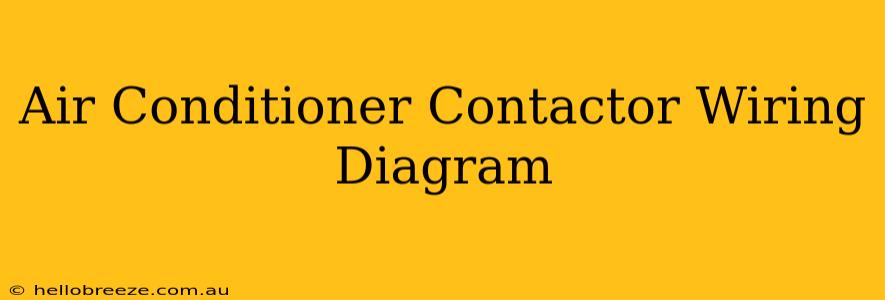Understanding your air conditioner's contactor wiring diagram is crucial for troubleshooting problems and ensuring safe operation. This guide provides a clear explanation of common wiring configurations and helps you decipher the often-complex diagrams found in AC units. Whether you're a homeowner tackling DIY repairs or an HVAC technician, this resource will enhance your understanding of AC contactor wiring.
What is an Air Conditioner Contactor?
The contactor in your air conditioner acts as a powerful switch, controlling the high-voltage power flow to the compressor and other major components. It's a critical safety and operational element, preventing damage and ensuring efficient performance. Understanding its wiring diagram is essential for diagnosing issues like:
- Compressor failure: A faulty contactor can prevent the compressor from starting.
- Overheating: Incorrect wiring can lead to overheating and potential damage.
- Cycling issues: Problems with the contactor can cause the AC unit to cycle on and off erratically.
Deciphering the Air Conditioner Contactor Wiring Diagram
Air conditioner contactor wiring diagrams vary depending on the specific unit's make and model. However, they generally follow a similar pattern. Key components and their corresponding terminals will typically include:
- Power Supply Terminals (L1, L2, etc.): These terminals receive power from the main power supply. Always ensure the power is disconnected before working with any wiring.
- Compressor Terminals (C, COM): These terminals connect directly to the compressor's motor windings. This is where the high-voltage power flows to start and run the compressor.
- Coil Terminals (A1, A2): The contactor coil receives a low-voltage signal from the thermostat or control board, activating the contactor. This low-voltage signal energizes the coil, causing the contactor to close and complete the high-voltage circuit to the compressor.
- Auxiliary Contacts: Some diagrams may include auxiliary contacts, used for controlling other components such as fans or other auxiliary equipment within the AC system.
Common Wiring Configurations
While variations exist, many AC contactor diagrams show a fairly standardized arrangement. Look for clear labels indicating the function of each terminal. Here's a generalized example:
Example:
- L1: Main power supply (hot)
- L2: Main power supply (hot)
- C: Compressor terminal (common)
- A1: Coil terminal 1
- A2: Coil terminal 2
Important Note: Always refer to your specific air conditioner's wiring diagram located in the unit's documentation or on a sticker inside the unit's access panel. Incorrect wiring can lead to severe damage or electrical shock.
Troubleshooting Common Problems
By understanding the wiring diagram, you can more effectively troubleshoot issues:
- No power to the compressor: Check the power supply connections (L1 and L2), the contactor coil (A1 and A2), and ensure the contactor itself is functioning correctly. A multimeter can be used to test voltage and continuity.
- Compressor runs intermittently: This could indicate a problem with the contactor coil, control board, or thermostat.
- Contactor buzzing or clicking: This usually indicates a problem with the contactor itself, potentially needing replacement.
When to Call a Professional
While understanding the wiring diagram can be helpful, working with high-voltage electricity is inherently dangerous. If you are uncomfortable working with electrical systems, always call a qualified HVAC technician. Incorrect wiring can lead to serious injury or damage to your air conditioning unit.
Keywords:
Air conditioner contactor, wiring diagram, AC contactor, compressor wiring, HVAC wiring, contactor troubleshooting, AC repair, electrical diagram, air conditioning repair, troubleshooting guide, HVAC troubleshooting, air conditioner maintenance, air conditioner components, contactor coil, power supply terminals, compressor terminals, auxiliary contacts, high-voltage wiring, low-voltage wiring.
This comprehensive guide provides a solid foundation for understanding air conditioner contactor wiring diagrams. Remember to prioritize safety and consult a professional when needed.

